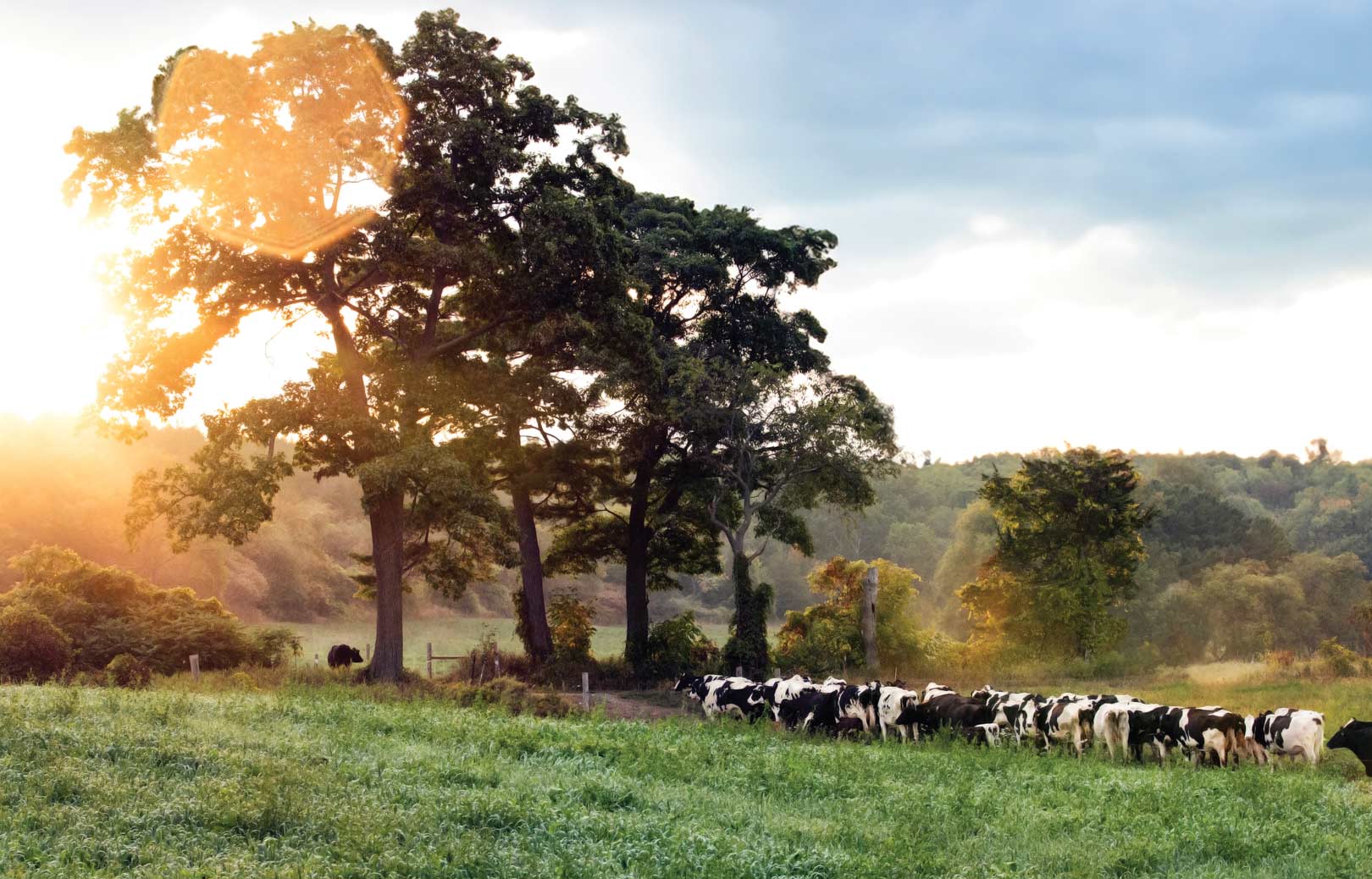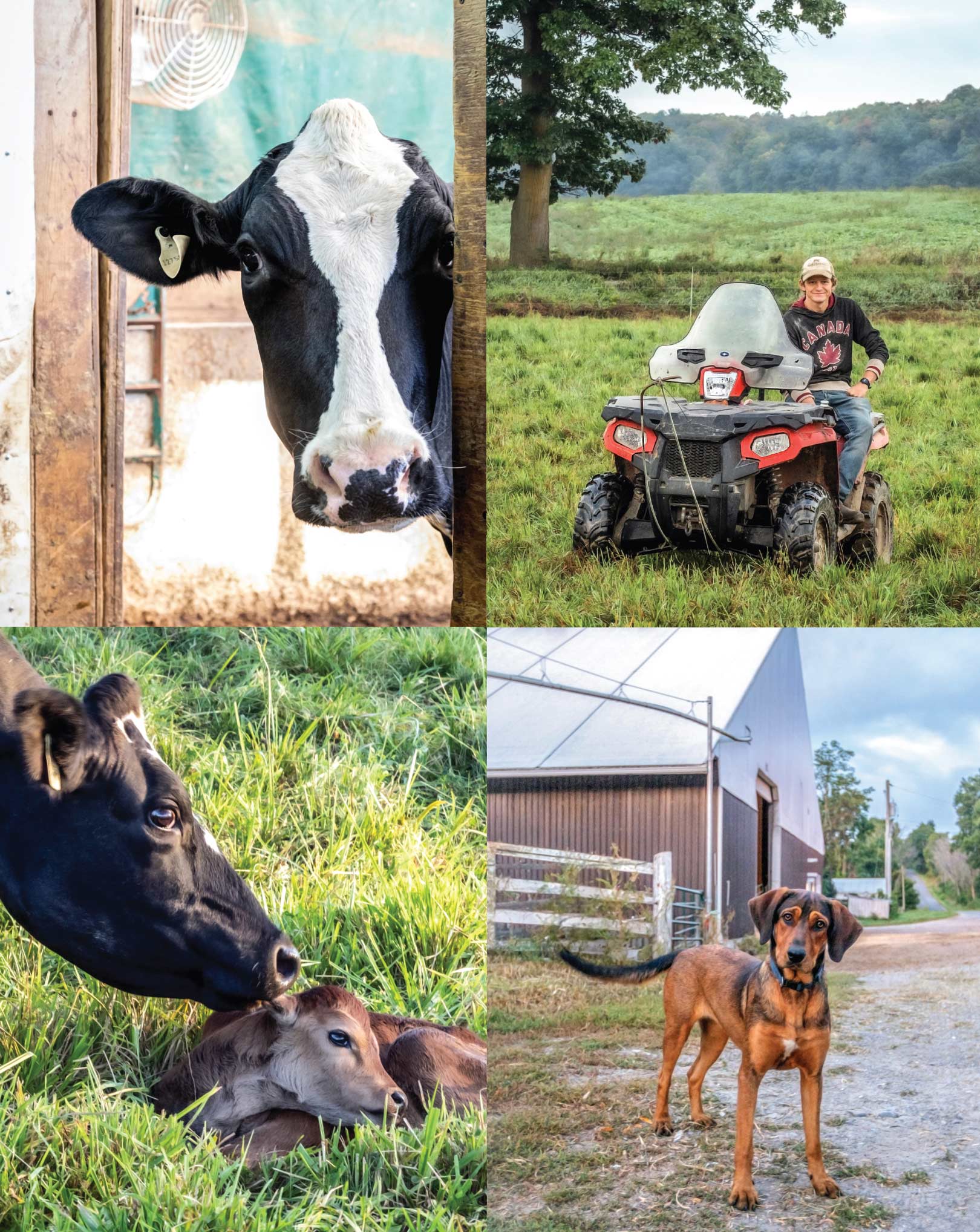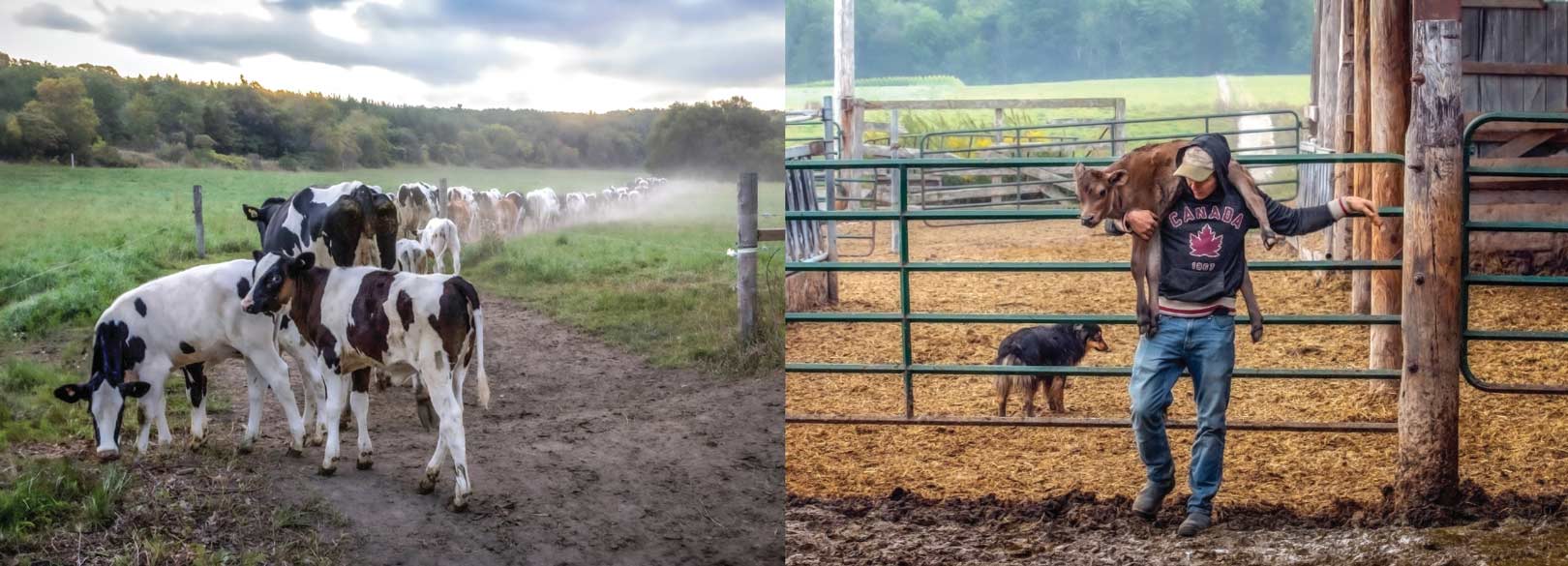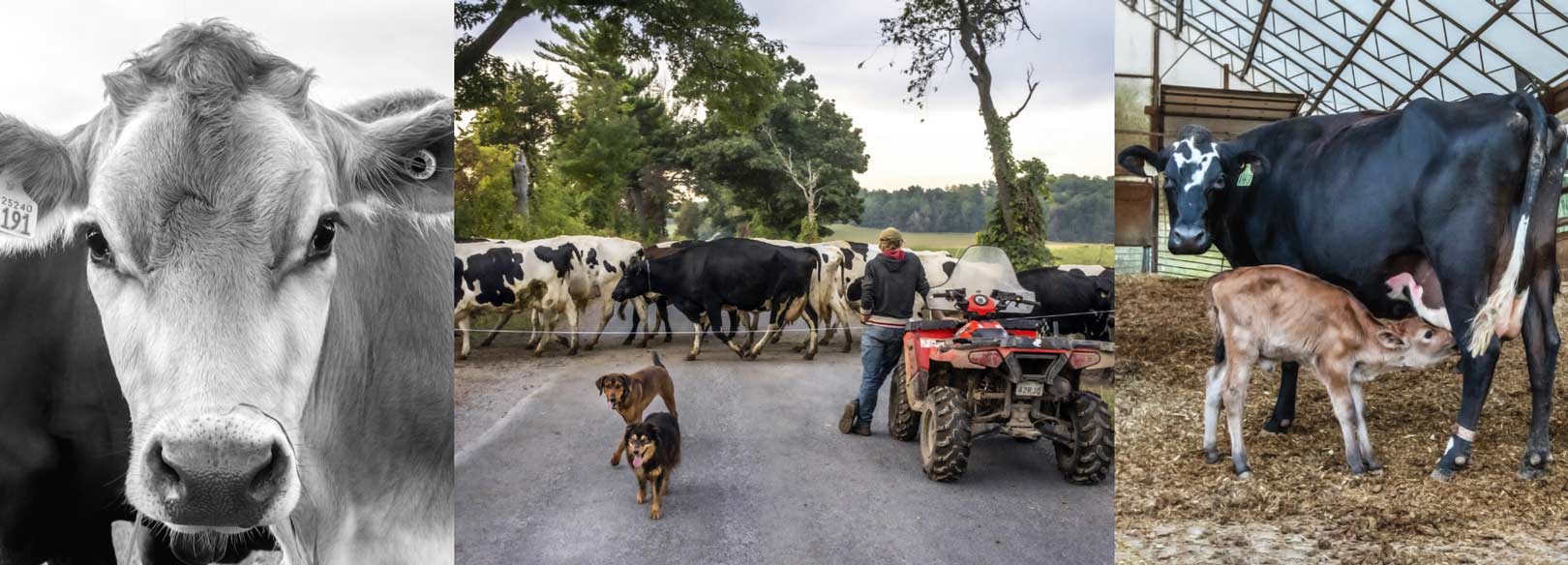


From left: The herd heads toward fresh pastures; Joel Fox transports one of Foxdale’s new calves

From left: One of Foxdale’s contented cows; the herd moves from pasture to pasture; a newborn calf nurses from its mother
The newborn calf blinks slowly, adjusting her eyes to the early morning light. Her mother’s soft mooing and gentle nudges encourage her to stand and nurse. The baby steadies herself on wobbly legs, and takes her first drink of milk. It’s a familiar scene to Joel Fox, and it bodes well for the herd. It’s five a.m. and it’s going to be a good day.
Foxdale Farm is on a quiet country road in a quiet corner of Quinte West, north of Wooler. When you first meet Joel Fox you get the impression he’s a regular guy with all the qualities of a hardworking dairy farmer. He’s unassuming and quiet, but this twenty-seven-year-old is a broad thinker with an active and innovative mind.
Joel and his father Jerry Fox work in partnership on land that was purchased by Joel’s great-great grandfather in the 1930s. Additional rented land brings the total area they farm to 450 acres. Farms like Foxdale aren’t so common these days. Even though agriculture is the largest employer in the Watershed region, there has been a dramatic decline in the number of small, family-run dairy farms in past decades.
“In March 1973, there were a total of 1,561 dairy farms in Hastings, Lennox & Addington, Northumberland and Prince Edward County,” says Charzie Abendanio, manager of communications for Dairy Farmers of Ontario. Today, there are one-tenth that number producing the same amount of milk.
The Foxdale operation looks like any other small farm: connected barns, tractors, cultivating equipment, fenced-in pens and sixty head of milk cows – a mix of Holstein, Jersey and an assortment of crossbreds. Twice a day, the cows are brought into the milking parlour. While larger farms install automated systems that can milk up to twenty cows at once, Foxdale’s smaller setup is manually controlled. With the help of part-time workers, they milk four cows at a time.
Lucy and Yuki, the two farm dogs, are involved in all the farm chores, rarely leaving Joel’s side, eyes bright, always enthusiastic.
The heifer calves born on Foxdale Farm are raised by Joel as potential candidates for the milking herd. Most bull calves are sold twenty kilometres up the road at Hoards Station Community Livestock Exchange (profiled in the Fall 2023 issue of Watershed).
A DIFFERENT APPROACH
After high school, Joel left the farm to attend the University of Guelph’s Ridgetown Campus, an agricultural college offering a unique two-year diploma that combines in-class lectures with on-farm work. He even ventured to Japan for an eight-month agricultural exchange. Although Joel had grown up on the farm, it was his time at college that stimulated new ideas for Foxdale.
One of the innovations Joel brought home from school was an alternative method of raising heifers. The majority of dairy farmers separate newborn calves from their mothers in the first few days after birth and house them either in outdoor calf hutches or in a building with individual pens. It’s critical for a newborn calf to receive high-quality colostrum from its mother within six hours after birth to transfer the antibodies they need to resist disease. These feedings continue every eight to twelve hours for three days. When calves are separated from their mothers, they must be hand-fed colostrum or a calf milk-replacer powder.
Farms like Foxdale aren’t so common these days. Even though agriculture is the largest employer in the Watershed region, there has been a dramatic decline in the number of small, family-run dairy farms in past decades.
Joel wanted to try another approach – extended cow-calf contact, which keeps a calf near its mother after birth. In this scenario, the calf remains with its mother for approximately eight weeks and is then gradually weaned over seven to fourteen days. The calves are eventually separated from their mothers at around seventy days.
When Joel presented the idea of extended cow-calf contact to Jerry, his dad was initially hesitant. But after discussion, “We decided to try a few calves with this system,” Jerry says. “It worked well, and we continued.” It’s a concept that would not succeed on all dairy farms, but at Foxdale Farm it’s a good fit, maintaining the high animal welfare standards Joel adheres to. The benefits in health and growth of calves, plus labour savings, reduced costs and improved profits, all add up to a win for both animals and humans.
Marina von Keyserlingk, a professor in the Faculty of Land & Food Systems, Animal Welfare Program at the University of British Columbia, believes this to be true: “In 2019, we published two systematic reviews that evaluated the available research on the effects of prolonged cow-calf contact on health, production and behaviour,” she says. “Our findings indicate that the available scientific evidence in support of early separation is weak. Indeed, the scientific evidence in support of cow-calf contact is much stronger.”
SHARING INFORMATION
Recently, Tracy Burnett, a University of Guelph research professor at Ridgetown Campus, asked Joel to return to his alma mater and speak to second-year agriculture students. “Bringing Joel into class is exciting because it opens the students’ eyes to farming practices that are not as common,” Tracy says. “Joel is extremely open to dialogue with the students and outlines all the places he thinks these practices are beneficial for his operation. He is also honest about any difficulties he’s had over time. It’s not often these students have a chance to pick the brain of a producer who keeps his calves and cows together. His visit is a highlight for many students.”
Joel is not comfortable with the limelight, but when he speaks about his work, he is confident in his role. His quiet passion for his farm and his herd shines through in his lectures. And his unassuming personality and common-sense approach to dairy farming are a hit with the students. “I speak farmer language,” he comments with a smile.
Derek Haley is Associate Professor of Applied Ethology and Animal Welfare at the University of Guelph’s Ontario Veterinary College. He asked Joel to present a lecture to his veterinary students. “This cow-calf contact was something I had mentioned in my lectures in quite a futuristic way,” says Haley, “and the students were excited to have Joel with us, who was already putting this straight into action.”
Joel’s quiet passion for his farm and his herd shines through in his lectures. And his unassuming personality and common-sense approach to dairy farming are a hit with the students. “I speak farmer language,” he comments with a smile.
YEAR-ROUND ACCOMMODATION
Foxdale’s cows spend the warmer seasons outdoors in the pasture, which involves moving the herd four times a day (to and from the pasture before and after milking, twice daily).
During winter months, the herd is housed in a compost-bedded pack-barn that was built on Foxdale Farm in 2014. This large open area provides space where cattle can move around with ease. The absence of stall dividers or physical barriers offers cows a choice of lying positions. Picture the cow version of a massive living room with an endless number of comfortable couches.
The compost bedding (wood shavings from a pallet plant in Cobourg) is aerated using cultivation twice a day. There is also a “creep” area bedded with straw in one corner of the barn for calves to hang out as they grow and gain independence from their mothers. Calves have access to the creep via a lower entrance, with hay, water and grain or calf-starter to help them grow healthy and strong. As with pasture-grazing, the calves mingle with the cows in the pack-barn 24/7.
All this amounts to fewer injuries and better herd health while minimizing costs.
WHY DID THE DAIRY HERD CROSS THE ROAD?
Along with care of the herd, pasture management plays a vital role in the success of Foxdale Farm. In addition to the hay crop (a mixture of alfalfa and orchard grass), the farm grows corn, wheat and soybeans. Approximately 130 acres of the 450 acres they work is pasture.
Cattle on Foxdale Farm are pasture- or grass-fed. The pastures are a mix of 50 percent grasses (orchard, timothy, fescue and brome grass) and 50 percent legumes (alfalfa, white clover, trefoil and red clover.) After wheat is grown, kale or peas are sometimes planted, offering another grazing option for the fall. Joel’s pasturing techniques come from his own “back-of-the-napkin” math and produce the results he wants. He adds, “We also rotate heifers from pasture to pasture every one to three days.”
Joel creates fresh pastures by using “bluff fencing” (a movable system of posts and spooled cable he transports on the back of his ATV), which can be put in place and electrified to contain the herd. Joel herds the cows from pasture to pasture. Sometimes these moves involve 60 cows plus calves crossing a country road. Joel jokes that one day as the cows were crossing, he noticed a car approaching down the sideroad. As a courtesy, he stopped a portion of the herd and took down the bluff fence to let the driver pass. When the driver drove by, he called out to Joel, “You didn’t need to do that. I was enjoying watching your cattle!”
Joel adds that the grazing cows drink from a portable water bowl, supplied by above-ground lines run from the barn. “We have a few kilometres of water line networks.”
As a bonus, farmers receive a higher price for products from grass-fed cows. Foxdale Farm ships their milk to Stirling Dairy which is owned by Gay Lea. “We receive a ten percent premium for being grass-fed,” Joel explains. “There are restrictions on what the cows can and cannot eat, the major restriction being that they can only consume a limited amount of grain. The dairy monitors the ratios.” Gay Lea sells grass-fed butter for double the price.
Joel creates fresh pastures by using “bluff fencing” (a movable system of posts and spooled cable he transports on the back of his ATV), which can be put in place and electrified to contain the herd. Joel herds the cows from pasture to pasture.
A PRODUCTIVE PASTURE
Last fall, Joel and Jerry Fox opened Foxdale Farm to the public for a Pasture Walk. According to Joe Banbury, one of the organizers, the concept of a walk through a farm began around 1985. The goal is to educate the general public and share ideas with other farmers. A few dozen folks attend each year. Joe’s sons are the sixth generation of a farming family who have been in the Brighton area since 1963, raising beef cattle and promoting pasture management. Back in 1988, Joe planted twenty acres of black walnut, and his sons now pasture cattle on the fifty-foot strips between the rows of walnut trees that cross the farm.
E. Ann Clark of Clark Farms near Warkworth is an Associate Professor of Crop Science at the University of Guelph and has worked in pasture and grazing management both as an academic and as a custom grazier for forty years.
“Unlike all other crops, pasture performs as dynamic communities of species – both sown and unsown – not as a monoculture,” she says. A grazier can promote healthy pastures by managing the choices of seeds, soil fertility, and grazing. “A successful pasture honours herd instincts and behaviour with respectful handling.”
SUNDOWN
Each season on a farm is defined by the rhythm of planting and harvesting, the welfare of the livestock and the constant worry about the weather.
Joel Fox is a steward of his land and a farmer who loves what does. He takes his calling seriously; he navigates daily challenges to find a balance between environmental and economic responsibility, between old and new methods.
It’s been a long day. Walking to the barn with Lucy and Yuki at his heels, Joel makes one last check on the farm’s early morning arrival. The new mother chews her cud and her calf sleeps soundly. All’s well.
Story by:
Lynn C. Bilton
Photography by:
Dave Carnahan



